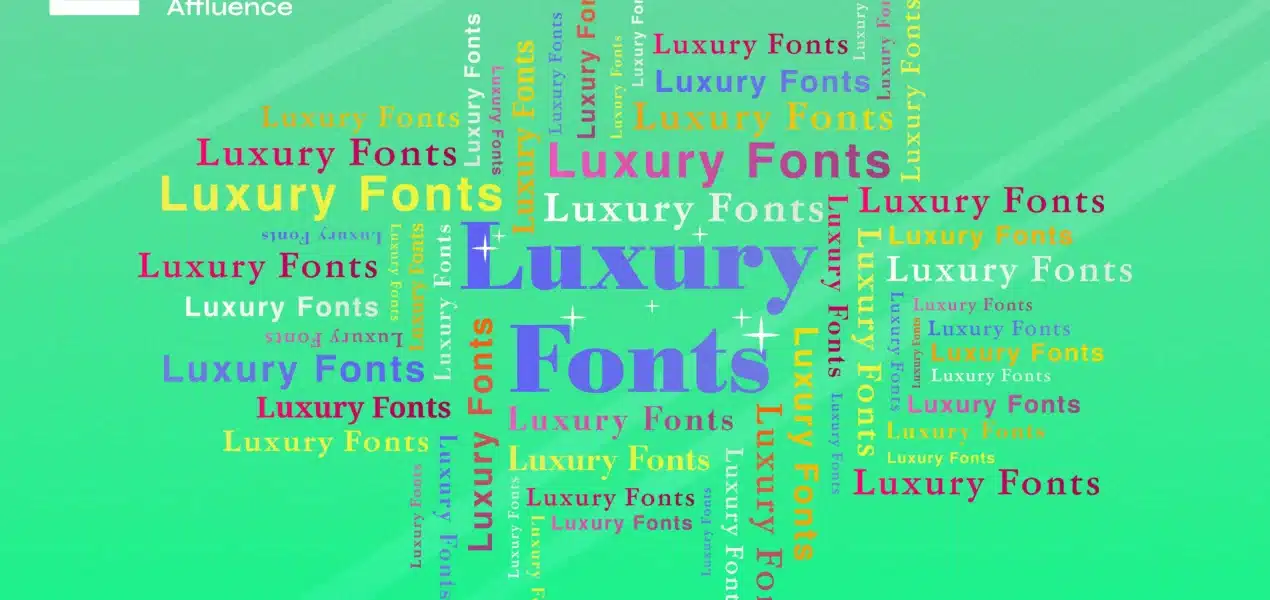Updated On: November 29, 2023 by Eman Sameh
The font you choose for your brand is much more than just a design element; it’s a critical component of your brand’s identity. In the world of branding and logo design, fonts speak volumes about a brand’s personality, values, and aspirations.
Luxury fonts for brands, in particular, hold a unique place in branding. They are not just tools of readability but carriers of prestige and elegance. These luxury fonts are often characterised by their clean lines, distinctive features, and an aura of exclusivity, making them a popular choice for expensive brands.
Why Do Luxury Fonts for Brands Matter?
Luxury fonts have the power to instantly elevate a brand’s perception. They convey a sense of sophistication and refinement that is essential for brands aiming to position themselves in the premium segment. A well-chosen luxury font can make a brand appear more valuable, trustworthy, and desirable. It’s not just about the style; it’s about the message it sends to the consumers. In a world where first impressions are crucial, the right font can make a lasting impact.
Examples of Famous Brands Using Luxury Fonts
• Chanel: The Chanel logo uses a Couture, sans-serif font, epitomising elegance and simplicity. Its balanced spacing and unembellished style are key to the brand’s timeless luxury, reflecting Chanel’s renowned position in the high-end fashion industry.
• Burberry: Burberry’s logo employs Bodoni, a serif font known for its elegant and impactful design. This choice underscores the brand’s commitment to tradition and reliability, aligning perfectly with Burberry’s heritage and esteemed reputation in luxury fashion.
• Rolex: Rolex’s logo incorporates Garamond, a classic serif font which exudes sophistication and durability. This font choice mirrors the brand’s dedication to excellence and enduring quality, a hallmark of luxury watchmaking.
• Prada: Prada’s logo features an Engry font, a bold and minimalist typeface. This modern, sans-serif font reflects Prada’s innovative and forward-thinking ethos in the luxury fashion industry.
• Tiffany & Co.: The Tiffany & Co. logo uses a distinct Sterling font, a delicate and elegant serif typeface. This font conveys a sense of elegance and exclusivity, aligning with Tiffany’s high-end jewellery offerings and luxurious brand image.
Top Luxury Fonts for Branding
When selecting luxury fonts for brands, the choice must reflect the brand’s prestige, quality, and exclusivity. Each font choice should not only align with the brand’s aesthetic but also resonate with its target audience, ensuring a seamless and impactful brand experience. Here’s a curated list of luxury fonts for brands, each with its unique history and characteristics that make them ideal for high-end branding:
1. Bodoni
Created in the late 18th century by Giambattista Bodoni, Bodoni has been a symbol of fashion and elegance for over two centuries. It’s known for its extreme contrast between thick and thin strokes and its unbracketed hairline serifs. Its crisp, clean appearance makes it a go-to for fashion brands. It conveys sophistication and modernity, ideal for brands seeking a timeless yet contemporary look.
2. Garamond
Garamond is a classic font that traces back to the 16th century, designed by Claude Garamond. It’s one of the most enduringly popular fonts in printing history. It’s a serif font known for its elegant, flowing lines and legibility. This font is perfect for brands that emphasise tradition and reliability. Its graceful, refined appearance appeals to a clientele seeking classic elegance.
3. Didot
Developed in the late 18th and early 19th centuries by the Didot family in France, Didot is synonymous with the fashion industry. It’s characterised by its strong contrast in line thickness, vertical stress, and fine serifs. Its high-end and fashionable look makes it suitable for haute couture brands and upscale magazines.
4. Helvetica
Designed in 1957 by Max Miedinger and Eduard Hoffmann, Helvetica is a neo-grotesque sans-serif typeface. It’s known for its clean, straightforward appearance with uniform strokes and minimalistic design. Its modern, neutral look makes it versatile for a range of luxury brands, especially those aiming for a minimalist and contemporary aesthetic.
5. Baskerville
Created in the 1750s by John Baskerville in England, Baskerville was part of the transition from Old Style to modern typefaces. It’s known for its sharp, contrasted strokes and slightly condensed structure. It’s ideal for brands that want to project a sense of history and authority while maintaining a modern touch.
6. Optima
Designed by Hermann Zapf in the 1950s, Optima is a humanist sans-serif font. It stands out with its classical Roman proportions and gentle stroke weight variation. Optima works well for brands that want to combine the formality of a serif font with the simplicity of a sans-serif.
Each of these fonts carries its unique flair and connotations, making them suitable for different types of luxury brands. Whether a brand leans towards traditional elegance or modern sophistication, there’s a luxury font that perfectly captures its essence. Selecting the right font is a key step in creating a brand identity that resonates with a discerning audience and stands the test of time.
How to Choose the Right Luxury Font for Your Brand
Selecting the right luxury fonts for brands is a crucial decision that can greatly impact your brand’s perception and appeal. It’s important to ensure that the font not only reflects the sophistication and values of your brand but also remains legible and functional across various mediums. Here are some key tips to consider when choosing a font that matches your brand personality, industry, and target audience:
1. Understand Your Brand Personality
Before diving into font choices, clearly define your brand’s personality. Is your brand traditional or modern? Bold or understated? Sophisticated or accessible? The font you choose should reflect these traits. For example, the combination of “Myriad Semi Bold” and “Gill Sans Roman” in the Rolls-Royce branding illustrates how the right font choices can create a nuanced and sophisticated brand identity, harmonising the brand’s legacy with its commitment to contemporary luxury and innovation.
2. Consider Industry Context
Different industries often favour different types of fonts. For instance, fashion and luxury goods tend to prefer clean, elegant serif fonts, while tech companies might lean towards modern, minimalistic sans-serif fonts. Apple, a leader in the tech industry, uses a simple sans-serif font called San Francisco, reflecting its focus on innovation and modern design.
3. Know Your Audience
Before choosing luxury fonts for brands, ask yourself: who are your target customers? Young, trend-focused audiences might appreciate a more contemporary font, while an older, more traditional customer base might resonate better with classic typefaces. A luxury brand targeting millennials might opt for a sleek, stylish font like Futura, which appeals to a modern aesthetic without sacrificing elegance.
4. Font Legibility and Scalability
Make sure the font you choose is easy to read across various mediums, from large billboards to small mobile screens. A great luxury font loses its appeal if it’s not easily readable. Tiffany & Co. uses a font that is not only elegant but also highly legible, ensuring that their branding is recognisable and accessible across all platforms.
5. Consider Pairing Fonts
Selecting luxury fonts for brands does not always mean using a single font. Pairing two complementary fonts can create a dynamic and visually appealing brand presence. For example, high-end magazines often pair a striking serif headline font with a more subdued sans-serif font for body text, achieving a balance of flair and readability.
6. Test and Get Feedback
- Before finalising a font, test it across various applications and get feedback from stakeholders and potential customers. This can provide valuable insights into how your font choice is perceived and its overall impact on brand communication. Additionally, consider the font’s versatility in different contexts, such as digital platforms and print materials, to ensure a consistent brand experience.
7. Stay True to Your Brand’s Core Values
The font should not only be aesthetically pleasing but also resonate with your brand’s core values and message. The luxury car manufacturer Mercedes-Benz uses a robust and recognisable font that reflects its values of quality, tradition, and luxury. By carefully considering these factors, you can select luxury fonts for brands that not only look great but also deeply resonate with your brand’s essence and audience. The right font choice is a key element in building a strong and cohesive brand identity that speaks directly to your desired market.
8. Integrate Luxury Fonts into Logo Design
Integrating luxury fonts into logo design involves more than just selecting a stylish typeface. It requires a deep understanding of both the technical and aesthetic aspects to ensure the logo not only looks luxurious but also functions effectively across various platforms. Here’s an overview of the technical aspects and some illustrative before-and-after examples of logo redesigns.
Technical Considerations
• Scalability: A logo must maintain its integrity and legibility in different sizes. Luxury fonts for brands should be chosen for their clarity and impact, whether the logo is on a large billboard or a small smartphone screen.
• Colour and Contrast: The colour palette used with luxury fonts in logos should complement the font’s style, enhancing its elegance and readability.
• Font Weight and Spacing: The weight of the font (bold, regular, light) can significantly influence the logo’s impact. Likewise, proper kerning (spacing between characters) is essential for readability and aesthetic appeal.
• Simplicity and Clarity: Luxury branding often revolves around simplicity and clarity. The font should not overpower the design but rather complement it.
Tips
• Test the font in various sizes and contexts to ensure it remains effective.
• Use contrasting colours for the background and font to ensure the logo stands out.
• Adjust spacing and weight to achieve a balanced and harmonious look.
• Avoid overly decorative fonts that might clutter the logo design.
Understanding the nuances of luxury fonts for brands is crucial in the realm of high-end branding. The right font not only encapsulates a brand’s essence but also elevates its identity in the competitive luxury market. By choosing fonts that resonate with their unique story and values, brands can create a lasting impression that truly stands out.











